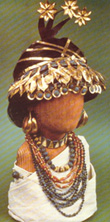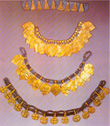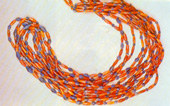|
|||||||||||||||||||||
|
|||||||||||||||
|
The most antique and spectacular jewels have been found in UR, in the old Babylonia (in the southern part of Irak). In the biblical Chaldei's city, the royal tombs returned an amazing abundance of gold jewels that may be dated in the middle of the IIIrd millennium b. C. (about 2500 b. C.) The richness and the variety of the jewels is without precedent. The jewels of the queen Pu-abi are wonderful, for which, an extraordinary fact in the goldsmith history, it was possible to reconstruct, because of the recovery site's condition, the original arrangement. A sophisticated hairstyle embellished the head: a network of thin gold strips formed a tiara on the forehead made of several circles of leaves and flowers in flatten gold and grain of hard stones. Several were the necklaces made of several thread of hard stone grain of different styles. Within these necklaces one stands out in particular, made of nine grooved triangular elements of flatten gold, alternated with as many triangular platelet made of lapislazuli. A variation to the above-mentioned model, that replaces the rigid platelet of hard stones with triangular elements made of small gold globes welded together, represents the most ancient and primitive example of the granulation technique. What ability and perfection in the incision and perforation of the stones: cylinder, bottle, melon, etc. What a fantasy in the styles of the different drop earring! Double growing earring, filigree and cloisonné rings, shows the inexhaustible inventiveness of the craftsmen, the taste for polychromy dealing and putting together different materials: gold, silver, lapislazuli and cornelian, all important. The metals were coming to the village of Sumer, from the mountains of Iran and Anatolia. The lapislazuli, the main precious stone, symbol of beauty, emblem of the divine power, from Afghanistan, the cornelian, especially the white-veined cornelian, from the Indo valley through the Persian gulf. Also for the men it was customary to embellish themselves with jewels, even though in a simpler manner than women. For the hair generally the style was limited to two pieces of gold chain, with at the center a big hard stone. A more elaborated form has at the center a gold disk with inlays of lapislazuli and cornelian. |
|
|||||||||||||




